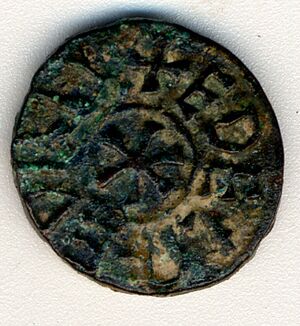Hexham Hoard facts for kids
Quick facts for kids Hexham Hoard |
|
|---|---|

Styca of Aethelred II from Hexham Hoard
|
|
| Created | c.850 (deposited), 9th century (mid) |
| Period/culture | Anglo-Saxon |
| Place | Hexham, Northumberland |
The Hexham Hoard is a huge collection of about eight thousand old copper-alloy coins. These coins were made by the Anglo-Saxon people who lived in the Kingdom of Northumbria a very long time ago, in the 9th century. The hoard was found by accident in 1832 near Hexham Abbey in Northumberland, England, while someone was digging a grave.
How the Hoard Was Found
The Hexham Hoard was discovered on October 15, 1832. A man named William Errington was being buried. His grave was being dug on the west side of Hexham Abbey. The person digging the grave was the sexton, Mr. Airey, and his helper. A sexton is someone who looks after a church and its graveyard.
The grave was dug deeper than usual. This is how the diggers hit a container holding the coins. The container was a bronze bucket. It broke when it was found. Mr. Airey knew the coins were important. He tried to keep them all together. But many coins were still lost before they could be properly studied.
The British Museum later got the broken bronze bucket. They were able to put it back together. An expert named John Adamson first wrote about and listed the coins. More coins were found when the grave was opened again in 1841.
What Coins Were in the Hoard?
The Hexham Hoard had about eight thousand Northumbrian coins called stycas. These were small coins made of a copper-alloy metal.
The hoard included coins from three kings:
There were also coins from two archbishops:
- Eanbald
- Wigmund
Some coins in the hoard were hard to identify. Experts call these "irregulars." This means it's tough to tell who made them.
The hoard did not have coins from King Osberht or Archbishop Wulfhere. Experts believe the hoard was hidden around the year 845. This was during the time of King Redwulf or King Aethelred II's second reign.
A coin expert named Elizabeth Pirie studied the stycas from Hexham. She also looked at coins from other hoards found in places like Kirkoswald and York. She helped create a way to classify and understand these old coins.
Where the Hoard Went
The Hexham Hoard was split up after it was found. Parts of the coin collection were sold to different museums and groups.
Some places that received coins from the hoard include:
- The British Museum
- The Society of Antiquaries of Newcastle
- The Ashmolean Museum (which also had a piece of the bucket for a while)
- Whitby Museum
- Manchester Art Gallery (where a package of coins from the hoard was "re-discovered" in 1977)

